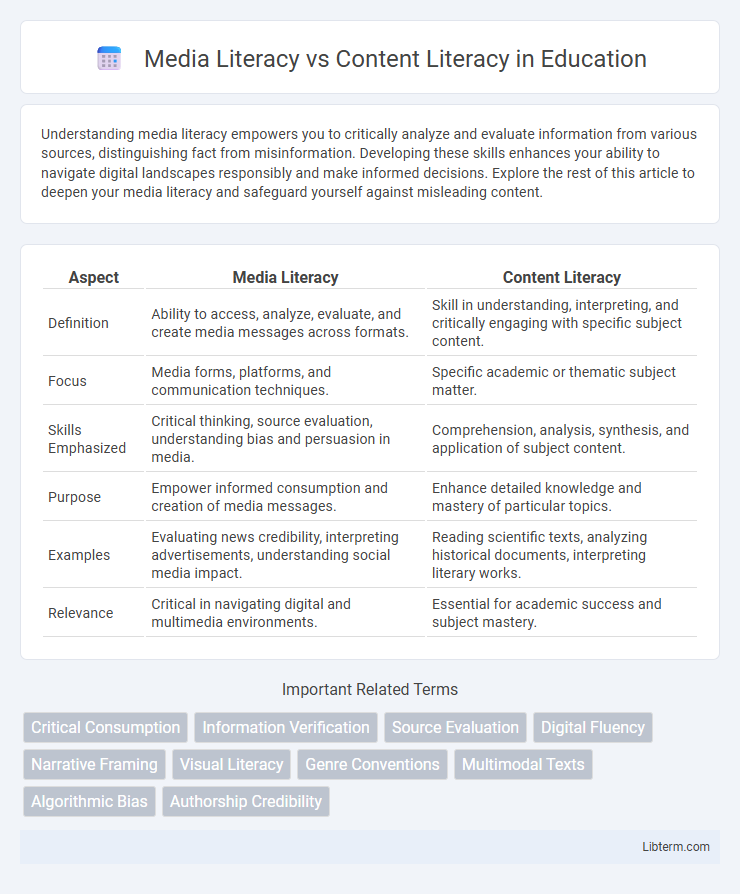Understanding media literacy empowers you to critically analyze and evaluate information from various sources, distinguishing fact from misinformation. Developing these skills enhances your ability to navigate digital landscapes responsibly and make informed decisions. Explore the rest of this article to deepen your media literacy and safeguard yourself against misleading content.
Table of Comparison
| Aspect | Media Literacy | Content Literacy |
|---|---|---|
| Definition | Ability to access, analyze, evaluate, and create media messages across formats. | Skill in understanding, interpreting, and critically engaging with specific subject content. |
| Focus | Media forms, platforms, and communication techniques. | Specific academic or thematic subject matter. |
| Skills Emphasized | Critical thinking, source evaluation, understanding bias and persuasion in media. | Comprehension, analysis, synthesis, and application of subject content. |
| Purpose | Empower informed consumption and creation of media messages. | Enhance detailed knowledge and mastery of particular topics. |
| Examples | Evaluating news credibility, interpreting advertisements, understanding social media impact. | Reading scientific texts, analyzing historical documents, interpreting literary works. |
| Relevance | Critical in navigating digital and multimedia environments. | Essential for academic success and subject mastery. |
Understanding Media Literacy: Definition and Scope
Media literacy involves the ability to critically analyze, evaluate, and create messages across various media formats, emphasizing understanding the influences, purposes, and contexts of media content. It encompasses skills such as recognizing bias, distinguishing between fact and opinion, and understanding the impact of media messages on audiences. Content literacy, on the other hand, focuses on comprehending and analyzing the specific subject matter within texts, requiring domain-specific knowledge and vocabulary proficiency.
Defining Content Literacy: Key Concepts
Content literacy involves the ability to comprehend, evaluate, and utilize information within specific subject areas such as science, history, or mathematics, emphasizing critical thinking and domain-specific vocabulary. It requires understanding the structure and purpose of texts, including textbooks, articles, and multimedia resources, to effectively absorb and apply knowledge. Mastery of content literacy enhances academic performance and empowers learners to engage deeply with subject matter, fostering analytical skills and informed decision-making.
Core Skills in Media Literacy
Media literacy core skills include critical thinking, analysis, and evaluation of various media sources to understand bias, purpose, and reliability. Content literacy emphasizes comprehension and interpretation of information within texts, focusing on vocabulary, structure, and meaning. Developing media literacy involves recognizing media messages' influence and decoding visual, audio, and digital content across platforms effectively.
Essential Abilities in Content Literacy
Content literacy requires critical thinking skills to analyze and interpret text, focusing on comprehension and evaluation of information within various formats like articles, reports, and textbooks. Essential abilities include identifying the author's purpose, recognizing bias, understanding context, and synthesizing information to draw informed conclusions. Mastery of content literacy enables individuals to engage deeply with subject-specific materials, enhancing overall academic and professional performance.
Differences Between Media and Content Literacy
Media literacy emphasizes the ability to critically analyze, evaluate, and interpret various media forms such as television, social media, and advertisements. Content literacy focuses on understanding and comprehending textual information within different subjects, including literature, science, and history. The key difference lies in media literacy's emphasis on decoding messages and identifying biases in mass communication, whereas content literacy centers on extracting meaning and interpreting information embedded in academic texts.
The Role of Technology in Media Literacy
Technology plays a crucial role in media literacy by enabling users to critically analyze and evaluate digital content through various tools and platforms. Digital devices and social media algorithms influence how information is consumed, requiring users to develop skills in discerning credible sources and detecting misinformation. Advances in AI and interactive media further shape media literacy by demanding continuous adaptation to new forms of content and communication.
Educational Approaches to Content Literacy
Educational approaches to content literacy emphasize critical thinking and comprehension skills tailored to specific subjects such as science, history, and literature. Techniques include analyzing texts, interpreting data, and evaluating sources to build deep understanding within curricular contexts. Integrating discipline-specific vocabulary and context aids in developing meaningful engagement with complex materials.
Why Media Literacy Matters in the Digital Age
Media literacy is essential in the digital age because it equips individuals with the skills to critically evaluate and interpret diverse media messages across platforms, enhancing their ability to discern credible information from misinformation. Unlike content literacy, which focuses on understanding specific subject matter, media literacy involves analyzing the purpose, bias, and impact of media content in various formats, including social media, news, and advertising. Developing media literacy fosters informed citizenship and protects users from manipulation in an increasingly complex digital information environment.
Integrating Both Literacies in the Classroom
Integrating media literacy and content literacy in the classroom enhances students' critical thinking and comprehension by equipping them to analyze media messages and understand subject matter deeply. Applying media literacy skills enables learners to evaluate sources and identify bias, while content literacy focuses on mastering specific disciplinary knowledge and vocabulary. Combining both literacies fosters a well-rounded educational approach that prepares students for informed participation in a digital and information-rich society.
Future Trends in Literacy Education
Media literacy and content literacy are converging in literacy education, blending critical thinking skills with digital and informational competencies. Future trends emphasize interactive technologies, such as AI-driven platforms and virtual reality, to enhance students' ability to analyze, evaluate, and create media content across diverse formats. Integrating adaptive learning systems aims to personalize literacy education, preparing learners for the complexities of an increasingly digital and information-rich society.
Media Literacy Infographic

 libterm.com
libterm.com